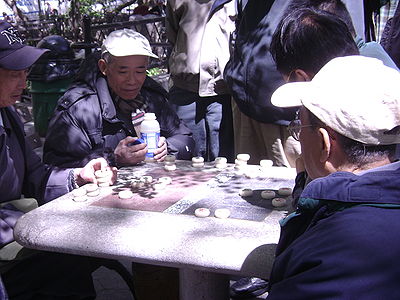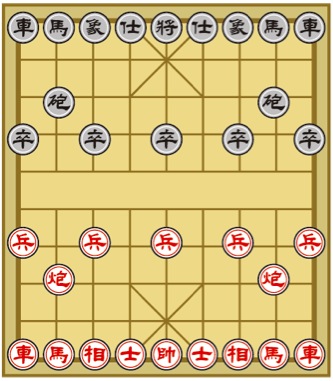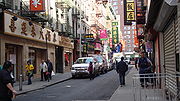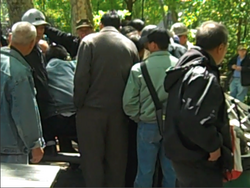From The Peopling of New York City
Contents |
Chinese Chess (象棋)
Columbus Park is located in Chinatown: between Baxter and Mulberry Street at 67 Mulberry Street.
Columbus Park has a designated section for Chinese senior citizens to sit on benches or play games. The most popular game in the park amongst the elderly Chinese immigrants is Chinese chess. It is similar to the more familiar Western-style chess in that it is a game of strategy that requires game pieces with different roles and the need to think ahead of your opponent. However, Chinese chess is unique in its own history, rules, and what it signifies to Chinese immigrants living in Chinatown.
History of Chinese Chess
Chinese chess has a very long and debated history. The origins of Chinese chess have not been confirmed, as it goes so far back in time. There are several stories and versions of Chinese chess's history, but none have been confirmed. However, from its rules and the origins of its Chinese name (Xiangqi), it is commonly believed to have started as a military tactic exercise that gradually evolved into a game.
China had four traditional arts: qin for music, hua for painting, shu for calligraphy, and qi for strategy games. The "qi" in Xiangqi stands for a type of strategy game, which further supports its possible militaristic origins. Many believed that Chinese generals would use a chess-like game to train their army, which is why the game is centered around the idea of war, getting to your opponent's territory, and taking their king or general. This military exercise later evolved into more modern "game" versions, which were played by both rich and poor in China, ultimately leading to the Chinese chess we have today.
How To Play Chinese Chess
Chinese chess is a two-player game. It includes a board and 32 pieces; each piece is assigned a role. The board is 9 lines wide by 10 lines long. The pieces are played on the intersections, which are known as points. The vertical lines are known as files, while the horizontal lines are known as ranks. The square marked with diagonal lines on each side of the board is each player’s “palace” or “fortress,” which restricts the opponent’s movements. Dividing the two opposing sides (between the fifth and sixth ranks) is the “river.” Although the river provides a visual division between the two sides, only a few pieces are affected by its presence: "soldier" pieces have an enhanced move after crossing the river, while "elephant" pieces cannot cross. There are seven roles: general, guard, elephant, horse, chariot, cannon, and soldier. Chinese chess is designed like a war or battle. Two armies advance into enemy territory on the board using strategic moves. Movements of the chess pieces are restricted by their roles, the “river,” and the “palace” on the board. The goal is to “capture” your opponent’s general.
Game Pieces
The park has designated tables with chess boards carved on them for the public to use. However, when the park gets crowded with chess players, some of the players also bring their own chess boards. There are paper ones, which usually come with a set of chess. Some people also bring in hand drawn chess boards. The most important part of the board are the lines and the river. Although the park supplies chess boards, the players must bring their own chess pieces. For those who are interested in obtaining chess pieces, most of the book stores around the area sell it. The price usually ranges from $5- $20, but it can also go up to $100 or more. The following are some pictures taken in the park of the various boards that they use. Click on the pictures to see a larger version of the chess board.
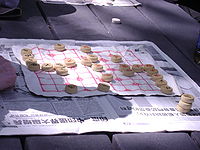
| 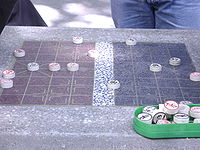
| 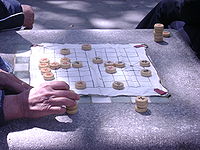
|
| Hand drawn chess board | Chess board at the park | Another chess board |
The generals are labeled with either the traditional Chinese character 將 (pronounced jiang) or 将 in simplified Chinese on the black side and 帥 / 帅 (pronounced shuai, meaning marshal) on the red side. Legend has it that originally the pieces were known as emperors, but when an emperor of China heard about the game, he executed two players for "killing" or "capturing" the emperor piece. After that, players called them generals instead. The general starts the game at the midpoint of the back edge (within the palace). The general may move one point either vertically or horizontally, but not diagonally. A general cannot move into a file which is occupied by the enemy general unless there is at least one piece positioned between the generals in the file. A special rule is that the general may not leave the palace.
The advisors (also known as guards or ministers, and less commonly as assistants, mandarins, or warriors) are labelled 士 (shì) ("scholar", "gentleman", "officer") for black and 仕 shì ("scholar", "official") for red. The advisors start to the sides of the general. They move one point diagonally and may not leave the palace, which confines them to five points on the board. They serve to protect the general. In western chess, this would be similar to the Queen chess pieces.
Guards and Generals:
The elephants are labeled 象 (xiàng, meaning elephant) for black and 相 (xiàng, meaning minister) for red. They are located next to the advisors. These pieces move exactly two points diagonally and may not jump over intervening pieces. If an elephant is blocked by an intervening piece, it is known as "blocking the elephant's eye." They may not cross the river and are usually used for defense moves.
The horses are labeled 馬 (mǎ) for black and 傌 (mà). Some traditional sets use 馬 for both colors. They begin the game next to the elephants. A horse moves one point vertically or horizontally and then one point diagonally away from its former position. The horse does not jump as the knight does in Western chess. A blocked horse is also known as "hobbling the horse's leg."
The chariots are labeled 車 for black and 俥 (jū) for red. Some traditional sets use 車 for both colors. The chariot moves and captures vertically and horizontally any distance, and may not jump over intervening pieces. The chariots begin the game on the points at the corners of the board. The chariot is considered to be the strongest piece in the game.
The cannons are labelled 砲 (pào) for black and 炮 (pào) for red. Each player has two cannons. The cannons start on the row behind the soldiers, two points in front of the horses. Cannons move like the chariots, horizontally and vertically, but capture by jumping exactly one piece (whether it is friendly or enemy) over to its target. There must be one piece (the “cannon platform”) between the cannon and the piece it wants to capture. The number of spaces between the cannon and the platform doesn’t matter, whether its 5 spaces or 0 spaces. When capturing, the cannon is moved to the point of the captured piece. The cannon may not jump over intervening pieces if not capturing another piece.
Each side has five soldiers, labeled 卒 (zú, meaning pawn/private) for black and 兵 (bīng, meaning soldier) for red. Soldiers are placed on alternating points, one row back from the edge of the river. They move and capture by advancing one point vertically. Once they have crossed the river, they may also move (and capture) one point horizontally. Soldiers cannot move backward, and therefore cannot retreat; however, they may move sideways at the enemy's edge (meaning, only after they have crossed the river into opponent’s board).
Blind Chess/Dark Chess
Another popular form of Chinese Chess is "暗棋", also known as “盲棋", which literally translates to "dark chess" and "blind chess", respectively. It is often played, as opposed to the regular game, because it requires a shorter amount of time. It, likewise, does not require as much thinking, since all of the moves are simpler than they are in regular games. Unlike the way regular chess is played, dark chess takes up only half of the chessboard. All of the pieces are covered and placed within the square, instead of on the intersecting points of the line. The game starts with the first person uncovering any one of the pieces on the board. The person will assume the color of that piece for the rest of the game. The opponent will take on the opposite color. For the most part, the function of each piece is greatly reduced. For example, "馬", or the horse piece, can only move one space at a time instead of several intersections like in regular Chinese chess. “炮“ or "cannon" is one of the few pieces that retains its function. The basic rules that the game follows are pretty simple. Any piece greater than or equal to another piece, can capture that other piece. “帥“ and “將“, also known as the "general", is one of the most powerful pieces in the game and can capture any piece, except “兵“ or “卒“, also known as the soldiers. The soldiers and the cannon, however, are at the same level and cannot capture each other unless the soldier can be captured through the cannon's jump move, which is having exactly one piece right next to the cannon in the direction of its target.
The dark chess has a greater element of luck involved than the regular form of Chinese Chess, since all of the chess pieces are covered. If the "general" is next to the "soldier", then the "soldier" can capture the "general" when it is revealed. Unlike regular chess where the "general" has to be checkmated, the dark chess can continue to function without a general. A person can win the game even if he or she lost his or her general. To win the game, one must capture all of the opponent's pieces. One of the common strategies to end the game is to force the pieces into corners where they cannot make any moves, which essentially is like capturing all the opponent's pieces; the last step is just not carried out yet.
There is also another variation of this game, in which the pieces can capture others without the target piece being turned over. This type of move is called "暗吃". In this scenario, the cannon, for example, can jump on another target in the same move if the target happens to be of an opposite color. If the target piece happens to be the same color, then the original piece, in this case the "cannon", would have to retreat back to its previous position. Pieces other than the cannon can also perform the same task. However, if the target piece is more powerful than the piece that it is capturing, then the piece that it is capturing would have to retreat, too.
An interviewee mentioned that dark chess is sometimes played at the park. One of the professional chess player interviewees is known for playing that type of chess. Some people believe that truly skillful Chinese chess players can win in dark chess, even when their luck is bad. It takes someone with experience and skills to overturn the tides.
Demonstration:
Culture of the Chess Players in the Park
Chinese Chess is an important leisure activity for the immigrants who go to Columbus Park. Some of the chess players live in the park's neighborhood, some are there because they have time to spend after taking their grandchildren to school, and some of them even travel from 8th Avenue or Bensonhurst. The general Chess-playing community is passionate about the game. Some players are so passionate about Chinese Chess that they will come to the park despite the bad weather. They are even willing to play Chinese Chess on the floor of the center building (the center building) on rainy days.
According to a well-known Chinese proverb, “觀棋不語真君子”, gentlemen are not supposed to comment on the games. This proverb sometimes can also be found written on the board. However, spectators do not always follow this rule. Many yell loudly about the moves the players made and they do not hesitate to suggest moves to the players. Some even move the pieces and demonstrate the subsequent possible moves. Our interviewee told us that this shows their passion in Chinese Chess, as they were easily excited by the change in the games. An interviewee describes this behavior as a "neighborhood cultural activity".
Some, however, are not happy when they are assisted in this fashion. For example, a female Caucasian interviewee mentioned that she believes this form of assistance hinders her learning. She also believes this behavior prevents her from learning through her own mistakes, which also does not provide her with enough time to think about the move. When the interviewee was asked whether she was aware of the aforementioned proverb, she was able to recall the proverb without any assistance. She thinks most people do not follow that and jokingly said that she should get a plaque with the proverb carved on it.
The problem with intrusive commenting is not present in highly skilled players. The highly skilled players seem to be more serious with their games. Although the skilled players often attract a larger crowd, nobody from the crowd would make a single comment on the moves. It was interesting to see a small group of observers argue about moves on one side, but the larger crowd, which has about 20 people surrounding 2 chess players, would not speak a single word during the game.
The players in Columbus Park would occasionally play chess for money. They do not really consider playing chess for money as gambling. They see it as "a game with prices". The amount varies and ranges from 5 dollars to 100 dollars per game. Commenting on a match for money is prohibited. If an observer makes a comment that's advantageous to Player A, the observer has to pay for the match if Player B loses, even if the comment made little contribution to Player A's victory. Gambling for money is a behavior that can also be observed overseas. According to the laws in Taiwan, a transfer of money grounded on the results of Chinese chess games qualifies as gambling and is illegal. There was a case on April 20th, 2010, when four elderly men whose age totaled up to 300 were brought back to the police station for interrogation, even though the amount of money involved was minimal (approximately $6).
Generally speaking, chess players are not supposed to un-do or take-back their moves. This courtesy is practiced by most players. However, chess-playing is a leisure activity after all, so some of them are not very uptight about it. The chess players can be very serious if they play games for money. We've witnessed a match in which they played for money during our visit; they were not allowed to change their mind once they placed their piece down, which made them extremely cautious with their moves.
Demographics
Most of the people who attend Columbus Park are Chinese, mainly because the park is located in the middle of Chinatown. However, one interviewee said that sometimes white people come and watch the game. One time, one of them even played the game! Slowly, New Yorkers are discovering this fascinating game and playing with the game’s original culture. Its intriguing to see how people of other cultures try to play despite the language barrier. A majority of the people in Columbus Park are immigrants who have arrived in the United States within the last ten to fifteen years and do not speak English well. Despite living in New York, many are only able to speak their native language: Chinese. According to The New York Times journalist Andrea Elliott, at least five different Chinese dialects are spoken in Columbus Park, including Cantonese (the most common language in Chinatown), Mandarin, Toisanese, and Shanghainese. The Chinese Chess tables are heavily populated with men. Likewise, the audience of the Chinese chess players are usually men that find it more exciting to watch than play.
Because the Chinese consider Chess a male-oriented sport, women, unlike the men, are often seen playing cards. In addition, Chinese Chess is associated with military tactics; the game itself is believed, by a population of players, to be created by Han Xin, who was a military tactician in the Han Dynasty. In many cultures, women are not involved in the military; they were taught to avoid non-feminine activities. This is a plausible reason for the game's lack of popularity with females. But of course, there are a number of female professional Chess players who have made their names known.
Most Chinese men who play Chinese Chess at Columbus Park belong to the older generation. An interviewee said that most of the people at the park do not have jobs; therefore they have a lot of time on their hands. In addition, these Chinese men cannot speak or understand English; they feel most comfortable, language and food wise, hanging around Chinatown. The location of Columbus Park is convenient for most of the Chinese men; however, some even hail from other areas and spend their time at the park after dropping their grandchildren off at school. Many of the non-residential chess players are from the other Chinese-populated areas, such as 8th Avenue and Bensonhurst.
The majority of the Chess players are immigrants. Chinese Chess is a common and traditional Chinese activity. Many Chinese-born men are more or less knowledgeable about the rules of the game, having learned them during their childhood. An interesting observation about Chinese Chess is that the chess sets sold in stores rarely come with a guidebook explaining the rules of the game. According to the impressions of the interviewees, most ABC's (American-Born Chinese) do not play the game at all, or at least do not do so at Columbus Park. However, they do occasionally see American-Born Chinese who are enthusiastic about learning the game; an interviewee recalled an instance when about 20 young children had come to the park in an attempt to learn the game. Interestingly, sometimes young people would even bring their laptops to the park in order to play Chess. Although the presence of young adults are scarce, they still leave an impression on other chess players. According to the New York Times article, "At Play in Chinatown's Backyard; Eastern Chess Meets Western Basketball Under the Mulberries", occasionally there are students from Bronx Science or Stuyvesant stopping by before returning home. According to one of the interviewee, one of the skillful players in the park is a Baruch student.
Non-Chinese players rarely show up in the park for the games. The language barrier is a major issue for players from other cultures. Interviewees reported that sometimes white people come to the park and observe the game. Currently, there is a white woman who visits the park on Saturday and Sundays to observe the games; she is serious enough to record the moves. Our interviewee also told us that on rare occasions, there are Koreans or Japanese players in the park. Those players are able to participate because they speak some Chinese.
Although it seems like overcoming the language barrier is necessary for non-Chinese players to participate in this activity, there was one interviewee who is able to get through without really knowing the language. When she first began to play, she had no background in any dialect of Chinese. Now she has slightly improved her listening skills -- she can somewhat understand when someone behind her is commenting on which move someone should make -- although she still refrains from attempting to speak in Chinese because of her accent. When asked whether it was difficult to memorize the pieces, the woman commented that there really are not that many pieces to remember. She also has some friends in the park whom she plays with. She is able to get through games without speaking in Chinese, especially since the spectators usually comment on each player's moves, allowing her to know if her move was good or bad by their reactions.
Gender Differences
When surveying the game playing area in Columbus Park, there is an obvious separation between men and women, not just in terms of where they sit, but in terms of the games they engage in. The game area is dominated by men most of the time, but there are usually some women sitting a few tables away. Like previously mentioned, the age range in this part of the park is from middle age to elderly, mostly elderly. The women are older and play games like the men; however, the games they play are not the same.
Women play an assortment of card games, such as Chinese Poker, and some other variations of card games. They may or may not have poker chips as part of their games. Although some have the poker chips with them, a lady mentioned that the purpose of the chips is to keep a record of who is winning. There is not that much gambling involved. It is interesting to note that the women sit away from the men by their own tables to play their own games. Of course, this is probably just practicality and not sexism or segregation. It would make sense to sit with people who are playing the same game, and this would inevitably place you away from people who are playing a different game. So the question here is: why do Chinese men play chess and sometimes card games, but Chinese women are almost never seen playing Chinese chess at all?
The answer lies in their history in China and their childhoods growing up in their home country. One's childhood shapes many aspects of a person's life later on, and in this case, Chinese chess was never part of girls' childhoods. As a result, they never got into the game. According to the chess-playing men at the park, one won't find an elderly Chinese woman playing chess because she probably never got the chance to do so when she was younger. In the "older days" in China, most were poor and playtime was a rare luxury. There was much work to be done, and time was consumed by either school or work. Girls were expected to stay home to do the housework and other "womanly" chores; they did not have the time to socialize, let alone learn the complex game of Chinese chess. Boys, on the other hand, had the option to go out and socialize with their friends, which ultimately led to playing games like Chinese chess. And since then, they just never learned and perhaps did not care to because women played other simpler games, such as card games.
But it was more than just housework and time, it was also a reflection of Chinese values. It was not considered "lady-like" for a young girl to be outside the house often. Girls were "locked up at home all day," according to the men at the park when they thought back to their childhoods. Chinese chess is a two-player game, and it is also a social game, so girls never had the opportunity to learn the game because they were not allowed out of the home. I can personally say that this value is still prominent among the Chinese immigrants here in the US. Often, sons would be allowed to stay out more frequently and later, while daughters are under very strict (and early) curfews. My own parents would give me the, "it's different, you're a girl, not a boy," lecture when we argued over the fairness of sex differences when it comes to venturing outside the house. To this day, it is considered offensive and disrespectful for girls to neglect their house chores to go out, more so than if a boy were to do the same. This value began in China and is still reflected here in the US amongst Chinese immigrants. Interestingly, this sex difference is illustrated by the differences in the games that Chinese immigrants play. This is why so many men play Chinese chess, but so few women play it.
Although not many Chinese women play chess, there was one Caucasian woman observing and sometimes playing in Columbus Park. Her first contact with Chinese Chess was when she signed up for the chess club in her school. She was expecting international chess and was fascinated by the different type of chess. She learned the basic rules in her club, although she did not have any experiences since the club members are reluctant to play with beginners. The woman found Columbus Park and observed chess games there on a regular basis. She mentioned that Columbus Park is one of the few places where people congregate regularly.
While she was there, she felt at ease. The male chess players did not treat her differently because of her gender, neither does she want to be treated differently. She felt strongly that any type of chess, whether western chess or Chinese chess, is the same for both gender. She does not like to participate in competition strictly assigned to one gender. The key aspect of chess is the strategy and logic, and not physical strength. She does not think females are at a disadvantage in that aspect. Moreover, she was also able to make some friends and play chess with them occasionally. Through her point of view, the chess players seem to have no difficulties in accepting players who are unlike them.
Chess Park Conflicts
In 2002, the fifth precinct in Chinatown gave the Columbus Park goers a warning regarding portable seats. As a populous and animated park, the Columbus Park attracted many individuals to spend his or her time there. However, there were not enough seats for everyone. Many spectators of the Chinese chess games and other activities brought their own chair, or in some cases, planks, soy sauce bottles, and buckets serving as chairs. Some brought their own tables, too. The immediate impact of this was congested traffic at the park. The area became overcrowded and also dirty. Moreover, those who brought chairs with them did not necessarily carry the chair back and forth from home to park. They left the chairs in a corner over night. Grouped with other objects used as seats, the corner depicted an image of a pile of garbage, according to James McCarthy, commanding officer of the fifth precinct. [1]
Based on several recent visits to Columbus Park, there seems to be no problem with using special objects as a replacement for chairs. Spectators and players gather at the chess tables and sits on the provided benches. For those who did not have enough seats, they stand around the table to watch the game. Although the park is crowded, one can still move around freely. In fact, chess game spectators often rotate from one table to another.
From time to time, chess players would have arguments with each other at the end of the game. Some would talk to each other in loud volumes and engage in heated discussion that almost sound like they are going to fight, but they are only debating which move would be the best move. The discussion sometimes still persists even after the game ends.
As previously mentioned in the cultural section, gambling is sometimes a problem, although a very minor one. According to the New York Times journalist Andrea Elliott in her article,"At Play in Chinatown's Backyard; Eastern Chess Meets Western Basketball Under the Mulberries", there is a sign near the tables warning the chess players that gambling is illegal. From time to time, the police would make arrests on the illegal activity.
Experience a Real Game at the Park
Too far away from the park or intimidated by the crowd, but you still want to know what it is like to play at the park? Don't worry, we have a solution for you. One of our fellow researchers, James, played a game with one of the chess players at the park. Click on the video below to see the whole game.
Chess Links
Below are two links that you can try out your skills if you want some practice at home instead of going to the park.
